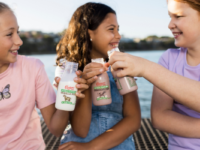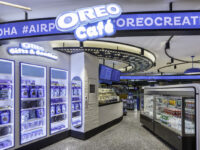 Veering away from the typical, Garçon Wines CEO has adopted a unique way of bottling wines- in flat bottles that is.
Veering away from the typical, Garçon Wines CEO has adopted a unique way of bottling wines- in flat bottles that is.
The wine wholesaler and packaging supplier from the UK has a global vision to develop and commercialise a wide range of wine packaging that is modern, fitting for the 21st century and encapsulates sustainable practices.
“Garçon Wines was born out of a wish to create a wine offering that was fit for a modern world. I had previously founded and built a wine business which was selling wine online and attempting delivery of this wine in round, glass bottles,” Santiago Navarro, CEO and co-founder of Garçon Wines told Inside FMCG.
“The key learning from this business was that we were using 19th century packaging – a heavy, spatially inefficient bottle which shatters easily – in a 21st century world of e-commerce, complex supply chains, resource scarcity and climate change.”
So why a flat bottle? Navarro said that it was a response to a problem he experienced first-hand that he believes other businesses must have encountered too.
“We wanted to create a wine bottle which would look beautiful on a dining table; respect the heritage and tradition of wine; would pack safely with minimal protective packaging; would be easy to transport and deliver and would offer a more sustainable packaging solution than the dominant round – glass bottle being used by most winemakers,” he shared with Inside FMCG.
Inside FMCG: How did you come up with the flat Bordeaux wine bottle?
Santiago Navarro: Most wines are bottled in one of two bottle shapes – Bordeaux and Burgundy. These bottles originate from the two French wine appellations of the same name – the appellations which are also home to the noble grape varieties which have spread successfully across the world of wine. So, as an example, a Cabernet Sauvignon wine from Barossa Valley would be bottled in a Bordeaux bottle, as Bordeaux is the home of the Cabernet Sauvignon grape variety. The same applies for a Chardonnay from Adelaide Hills, it would be bottled in a Burgundy bottle, as the home of the Chardonnay grape is Burgundy.
Of the two bottle shapes, the Bordeaux shape is more commonly used and is best recognised as the shape of a wine bottle, so we chose to launch with a flat Bordeaux bottle first, knowing that subject to the success of our business, we would follow on shortly after with a flat Burgundy bottle. There’s beauty in the heritage of wine and we intend to introduce innovation which respects and retains as much of the tradition as possible, whilst advancing the 19th century wine bottle into the 21st century.
Inside FMCG: Many companies now are focusing on creating sustainable products. Tell us how your company embodies it?
In our view, companies need to accelerate the process of adopting and implementing sustainable products as the world needs action yesterday not tomorrow. It’s also important to highlight that sustainability should not be confused with being eco-friendly. For us sustainability is about ensuring we create a healthier planet, wealthier industry and happier society. Our packaging innovations achieve all three.
Most importantly, because our wine bottle is the lightest, most spatially efficient, 75cl wine bottle in the world, and made from 100 per cent post-consumer recycled PET, it’s the ideal 21st century bottle – unbeatably cost effective for wine’s supply chain and eco-friendly for our planet’s health.
In addition, our multi award-winning, flat wine bottle offers the following specific benefits:
1) It’s 87 per cent lighter and 40 per cent spatially smaller than an average round, glass wine bottle of the same volume offering unbeatable supply chain, logistics, cost-savings and eco-friendly benefits – extrapolating figures from the circular economy experts WRAP, the savings could cut 500g of CO2 emissions per bottle;
2) It’s made of 100 per cent post-consumer recycled PET creating a value for plastic already in circulation, putting it back to good use, funding and fuelling its collection and helping mitigate against it being discarded to landfill or littering our environment;
3) It’s supplied with a plastic cap to ensure full and easy recyclability after use, since the collar from a standard aluminium screw cap closure inhibits full recycling, and being the greenest wine bottle in the world is fundamentally important to us.
Inside FMCG: What is an oxygen scavenger? How does it make a difference compared to other wine bottles?
Our bottles are made of 100 per cent post-consumer recycled PET. [It] is permeable to oxygen and therefore in order to boost the shelf life of the wine in our bottles to be at least one year, we include a barrier technology into the PET. The barrier technology we use is a food-safe, fully recyclable additive which is included with the PET and which is an active oxygen scavenger and passive carbon dioxide barrier. The oxygen scavenger does as its name implies, it scavenges the oxygen to stop it oxidising the wine. This gives our bottles the performance required to bottle the types of wines which would be bottled and consumed within the same vintage, which makes up a large part of wines. We are now looking at other sustainable and recyclable coatings which would allow us to boost the shelf life beyond two years. We are always looking to improve our product and we have a strong pipeline of improvements and innovations coming up.
Inside FMCG: Is it costly to produce this type of wine bottle?
Most wine bottles are produced from glass. Producing one of our wine bottles in post-consumer recycled PET is less costly than producing a wine bottle from glass. This should come as no surprise to anyone engaged in packaging, as at scale, PET bottles are most cost-effective than glass as they use significantly less energy to produce. This is also why they are considerably less harmful to the environment. A glass bottle needs to be reused at least 20 times before its carbon emissions become equivalent to that of a plastic bottle that gets recycled.
Inside FMCG: What’s the difference between using bag-in-box wine and screw cap bottles?
Whilst we’re of the view that screw cap is a great innovation and one which we support and use ourselves, we feel that bag-in-box is lacking in the emotional and experiential of wine. This is an area we have put much focus on. We offer a 21st century wine bottle – which importantly is still a bottle and looks like one. We believe consumers want to drink wine from a bottle and one that looks beautiful on a dining table – we’ve achieved this. In our view, bag-in-box could never replace round, glass bottles as the dominant, primary packaging for wine, but we offer a 21st century wine bottle and therefore stand a good chance of replacing the 19th century wine bottle and becoming the dominant primary packaging for wine.
The flat wine bottle is a British invention for which we have granted intellectual property protection in a large part of the world of wine, including Australia and neighbouring New Zealand. It’s our intention to fully share our innovation with Australian wine producers. Australia produces some of the best wine in the world and it travels right across the world, bringing happy moments to consumers right across the globe. We hope to help Australian wines travel internationally, more sustainably and we already have commercial discussions ongoing with a number of Australia’s most successful wine companies.
Inside FMCG: The flat Bordeaux wine bottle design has won multiple awards. What else can Garçon do in terms of innovation in the liquor industry?
Our flat Bordeaux bottle has received close to 20 awards or accolades in a little over one year showing how well it has been received… In addition to the flat Bordeaux bottle, we have also recently launched a 10 flat bottle case which significantly reduces the costs and carbon emissions from the supply chain of wine… Then we will shortly be releasing a flat Burgundy bottle which will enable us to offer a more complete solution of primary packaging for wine. The flat Burgundy bottle has also been designed to be packed into a space saving 10 bottle case, which will be compact and game-changing as is the case for the flat Bordeaux bottles.
Inside FMCG: Do you plan to open a click and mortar store in the future?
We presently have no existing plans to open a bricks and mortar store in Australia or anywhere else. Currently, we’re exclusively a B2B company dealing with other companies who in turn sell wine to consumers. Whilst there may be markets where we end up offering a B2C offering, at the moment we will focus on the B2B opportunities.
Having said this, whilst we may not be planning to open our own physical retail stores, there are plenty of opportunities in our pipeline where our bottles will be offered in bricks and mortar stores. This extends way beyond our home market of the UK. Smaller retail stores see significant benefits from being able to retail wine in bottles which take up considerably less shelf space in store. And in markets such as Scandinavia where the environmental impact of packaging is so important to consumers, then the interest in our innovative bottles is significant.
Inside FMCG: Any plans to bring Garçon Wines to Australia?
Yes, most definitely we will bring our innovative wine packaging products to Australia. In fact, we’re already speaking positively and on a very regular basis with a varied number of Australian wine producers of different sizes – from the very large to the boutique. We’re confident that in 2019 our bottles will be offered both in Australia but also with Australian wines across the globe. To date, we have bottled some Australian Shiraz and Chardonnay which we have offered to UK gifting companies. These wines have been well received. So, our relationship with Australia already exists and it’s only likely to grow further over the months and years to come.



















